Inside The New York Botanical Garden
Esther Jackson
Posted in From the Library on May 8 2017, by Esther Jackson
Esther Jackson is the Public Services Librarian at NYBG’s LuEsther T. Mertz Library where she manages Reference and Circulation services and oversees the Plant Information Office. She spends much of her time assisting researchers, providing instruction related to library resources, and collaborating with NYBG staff on various projects related to Garden initiatives and events.
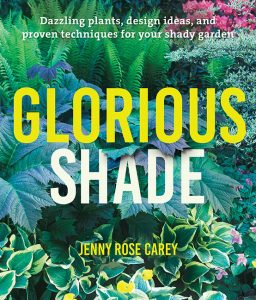 Glorious Shade from Jenny Rose Carey and Timber Press is a lovely meditation on shade gardening. Carey, the senior director at the Pennsylvania Horticultural Society’s Meadowbrook Farm, is a talented writer and photographer, and she frames her book as a conversation about shade gardening. After an introduction detailing different kinds of shade, the narrative ambles through different topics related to shade gardening, culminating in an extensive and beautifully photographed plant palette. Chapter titles include “Shades of Shade: Observing Shifting Patterns in Your Garden,” “The Gardener’s Calendar: Seasonal Changes in the Shade Garden,” “Down and Dirty: The Intertwined, Underground World of Soil and Roots,” “Planting for Success: Techniques and Maintenance,” “Designing in the Shadows: Bright Ideas of Shady Spaces,” and “The Plant Palette: Choosing Plants for Your Shade Garden.”
Glorious Shade from Jenny Rose Carey and Timber Press is a lovely meditation on shade gardening. Carey, the senior director at the Pennsylvania Horticultural Society’s Meadowbrook Farm, is a talented writer and photographer, and she frames her book as a conversation about shade gardening. After an introduction detailing different kinds of shade, the narrative ambles through different topics related to shade gardening, culminating in an extensive and beautifully photographed plant palette. Chapter titles include “Shades of Shade: Observing Shifting Patterns in Your Garden,” “The Gardener’s Calendar: Seasonal Changes in the Shade Garden,” “Down and Dirty: The Intertwined, Underground World of Soil and Roots,” “Planting for Success: Techniques and Maintenance,” “Designing in the Shadows: Bright Ideas of Shady Spaces,” and “The Plant Palette: Choosing Plants for Your Shade Garden.”
Carey touches on a variety of topics, and the more unique parts of her book relate to shade plants with specific seasonal interest, suggestions of appropriate under-plantings for specific trees, and, of course, her wonderful plant palette. In terms of practical advice about garden installation and design, the book is a bit too general for either a beginner or an expert. However, in all, Glorious Shade is an excellent reference for gardeners working with shaded areas who are looking for inspiration in terms of garden design and new plants to trial. For those who simply love beautiful garden books, Glorious Shade is also appropriate, as Carey’s photographs are lovely and the book’s visual design is excellent.
Read More
Posted in From the Library on May 1 2017, by Esther Jackson
Esther Jackson is the Public Services Librarian at NYBG’s LuEsther T. Mertz Library where she manages Reference and Circulation services and oversees the Plant Information Office. She spends much of her time assisting researchers, providing instruction related to library resources, and collaborating with NYBG staff on various projects related to Garden initiatives and events.
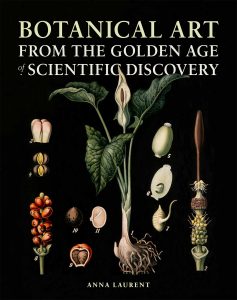 Botanical Art from the Golden Age of Scientific Discovery was one of my Top 10 Popular Science Books of 2016. As I wrote in my earlier review, author Anna Laurent has curated an exquisite collection of historic botanical art. “More than an archive of illustrations and inquiry, this book documents an extraordinary convergence of disciplines that flourished in the late nineteenth and early twentieth centuries,” she writes. “Europe was enjoying a golden age of scientific discovery; naturalists were exploring the globe and there was a clamoring for knowledge of the natural world.”
Botanical Art from the Golden Age of Scientific Discovery was one of my Top 10 Popular Science Books of 2016. As I wrote in my earlier review, author Anna Laurent has curated an exquisite collection of historic botanical art. “More than an archive of illustrations and inquiry, this book documents an extraordinary convergence of disciplines that flourished in the late nineteenth and early twentieth centuries,” she writes. “Europe was enjoying a golden age of scientific discovery; naturalists were exploring the globe and there was a clamoring for knowledge of the natural world.”
The art in this book comes specifically from botanical wall charts. These charts were created as teaching tools during the 19th and 20th centuries. Produced by professors, biologists, illustrators, writers, and botanists, wall charts were used in classroom instruction to supplement lessons involving living or vouchered plants. These wall charts were first documented in Germany in the 1820s. In addition to featuring many beautiful German charts, the book includes examples of charts from various countries.
Read More
Posted in From the Library on April 21 2017, by Esther Jackson
Esther Jackson is the Public Services Librarian at NYBG’s LuEsther T. Mertz Library where she manages Reference and Circulation services and oversees the Plant Information Office. She spends much of her time assisting researchers, providing instruction related to library resources, and collaborating with NYBG staff on various projects related to Garden initiatives and events.
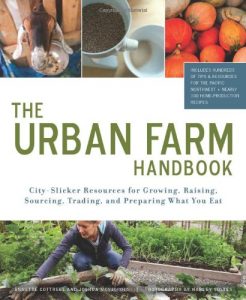 The Urban Farm Handbook: City-Slicker Resources for Growing, Raising, Sourcing, Trading, and Preparing What You Eat is a 2011 book by Annette Cottrell and Joshua McNichols for Skipstone. The word “handbook” is frequently applied to a variety of books, some useful and some less useful. “Handbook,” in the case of Urban Farm Handbook, is appropriately used, as Cottrell and McNicols provide readers with hundreds of tips and resources for every aspiring and current urban homesteader.
The Urban Farm Handbook: City-Slicker Resources for Growing, Raising, Sourcing, Trading, and Preparing What You Eat is a 2011 book by Annette Cottrell and Joshua McNichols for Skipstone. The word “handbook” is frequently applied to a variety of books, some useful and some less useful. “Handbook,” in the case of Urban Farm Handbook, is appropriately used, as Cottrell and McNicols provide readers with hundreds of tips and resources for every aspiring and current urban homesteader.
Handbook is divided into four seasons. Each season includes suggested seasonal chores related to food, both plant and animal. Do you want to keep chickens for eggs? Plant a vegetable garden? Learn home food preservation? Raise and slaughter rabbits for meat? All this and more is discussed in the Handbook. Readers can jump into a chapter to learn about a single topic, or read the book from cover to cover and get the tools for undergoing a radical lifestyle change.
Read More
Posted in From the Library on April 14 2017, by Esther Jackson
Esther Jackson is the Public Services Librarian at NYBG’s LuEsther T. Mertz Library where she manages Reference and Circulation services and oversees the Plant Information Office. She spends much of her time assisting researchers, providing instruction related to library resources, and collaborating with NYBG staff on various projects related to Garden initiatives and events.
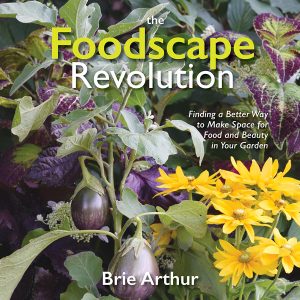 The Foodscape Revolution: Finding a Better Way to Make Space for Food and Beauty in Your Garden is a new book by Brie Arthur for St. Lynn’s Press. This charming and accessible book offers guidance for new gardeners and inspiration for the more experienced.
The Foodscape Revolution: Finding a Better Way to Make Space for Food and Beauty in Your Garden is a new book by Brie Arthur for St. Lynn’s Press. This charming and accessible book offers guidance for new gardeners and inspiration for the more experienced.
From the first page, Arthur draws the readers in with a friendly, assuring, and easy tone. She writes for people who want to grow edible plants and also for those who have a love for ornamentals. As such, she advocates for “foodscaping,” or growing food alongside flowers in a landscape that already exists. By mixing annual vegetables with perennial ornamentals (or other combinations), home gardeners can have access to delicious and organic produce without sacrificing the ornamentals they love.
Read More
Posted in From the Library on February 24 2017, by Esther Jackson
Esther Jackson is the Public Services Librarian at NYBG’s LuEsther T. Mertz Library where she manages Reference and Circulation services and oversees the Plant Information Office. She spends much of her time assisting researchers, providing instruction related to library resources, and collaborating with NYBG staff on various projects related to Garden initiatives and events.
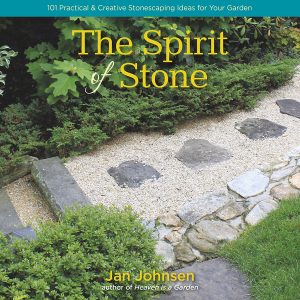 Jan Johnsen’s The Spirit of Stone is a new book from Pittsburgh-based publisher St. Lynn’s Press. Johnsen, an instructor with The New York Botanical Garden’s Adult Education Department, brings 40 years of experience to bear in her newest book. In the introduction of The Spirit of Stone, Johnsen writes:
Jan Johnsen’s The Spirit of Stone is a new book from Pittsburgh-based publisher St. Lynn’s Press. Johnsen, an instructor with The New York Botanical Garden’s Adult Education Department, brings 40 years of experience to bear in her newest book. In the introduction of The Spirit of Stone, Johnsen writes:
Stone is often an overlooked player in a landscape. While we may swoon over the many shapes and colors of plants within a garden, the stone walks and walls stand silently by, perhaps unnoticed. This book shines a light on the beauty and enchantment that natural stone adds to an outdoor setting. It is a celebration of the versatility of solid, durable rock and showcases the many ways stones and stonework can be featured in the landscape.
Read More
Posted in From the Library on February 13 2017, by Esther Jackson
Esther Jackson is the Public Services Librarian at NYBG’s LuEsther T. Mertz Library where she manages Reference and Circulation services and oversees the Plant Information Office. She spends much of her time assisting researchers, providing instruction related to library resources, and collaborating with NYBG staff on various projects related to Garden initiatives and events.
 Unseen City: The majesty of pigeons, the discreet charm of snails & other wonders of the urban wilderness is Nathanael Johnson’s journal documenting the journey of teaching his daughter about the natural wonders of their home city, San Francisco. For me, the beginning of this book was what really shone. Johnson writes about his daughter’s habit as a toddler to ask “that?” when pointing at all number of objects in and features of her environment. In addition to identifying things like “house” or “sky,” Johnson found himself saying “tree” so frequently that he decided to change the way in which he replied to his daughter. He writes:
Unseen City: The majesty of pigeons, the discreet charm of snails & other wonders of the urban wilderness is Nathanael Johnson’s journal documenting the journey of teaching his daughter about the natural wonders of their home city, San Francisco. For me, the beginning of this book was what really shone. Johnson writes about his daughter’s habit as a toddler to ask “that?” when pointing at all number of objects in and features of her environment. In addition to identifying things like “house” or “sky,” Johnson found himself saying “tree” so frequently that he decided to change the way in which he replied to his daughter. He writes:
“I added a rule to complicate the game—I would give the same answer only once per outing. The second time Josephine inquired about a tree, I would have to be more specific. ‘Trunk,’ I would say, or leaves, a branch, a twig, a flower. And it was in this way that I noticed for the first time, though I’d walked by this tree hundreds of times, that it had tiny yellow flowers. The leaves were long and narrow, dark green on the top and, on the underside, nearly white, spotted with black. At the center of each cluster of leaves were tiny yellow flowers. I picked a few (a difficult task because breaking the supple green branch was like tearing a red licorice rope) and stuffed them in my pocket.”
Many fellow naturalists will see themselves reflected, to some extent, in this passage. Johnson and his daughter are curious explorers and hungry to understand more about the organisms in their environment. The real strength of Johnson’s book is how accessible he makes exploring one’s natural surroundings, even in a city. The section “Some Practical Recommendations for Neighborhood Naturalists” is spot on, and easy enough to follow with children.
Read More
Posted in From the Library, Shop/Book Reviews on February 6 2017, by Esther Jackson
Esther Jackson is the Public Services Librarian at NYBG’s LuEsther T. Mertz Library where she manages Reference and Circulation services and oversees the Plant Information Office. She spends much of her time assisting researchers, providing instruction related to library resources, and collaborating with NYBG staff on various projects related to Garden initiatives and events.
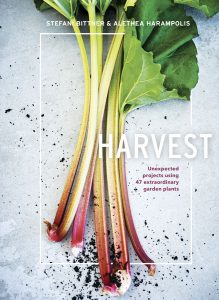
Harvest: Unexpected projects using 47 extraordinary garden plants is a delightful new book from Ten Speed Press. This is the fourth book from author pair Stefani Bittner and Alethea Harampolis whose other titles include The Beautiful Edible Garden, Branches & Blooms, and The Flower Recipe Book. Harvest contains projects related to cooking, craft beverages, beauty care, decorations for the home, and flower arranging. Beautiful photographs by David Fenton accompany the projects. With plants and projects divided into three growing seasons, early (late winter to spring), mid (summer to early fall), and late (late fall to early winter), the book is an eclectic mix of inspiring ideas and ethereal photographs.
Read More
Posted in From the Library on January 30 2017, by Esther Jackson
Esther Jackson is the Public Services Librarian at NYBG’s LuEsther T. Mertz Library where she manages Reference and Circulation services and oversees the Plant Information Office. She spends much of her time assisting researchers, providing instruction related to library resources, and collaborating with NYBG staff on various projects related to Garden initiatives and events.
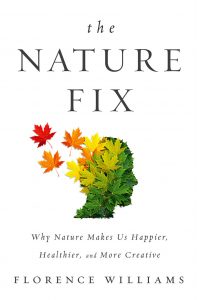 Why do some of us feel happier, healthier, more relaxed, or more energized by nature? Why does an isolated hike in the woods illicit strong feelings of contentment, while a walk in an urban green space devoid of trees fails to inspire the same feelings? Different people have different reactions to time spent in nature, of course, but why do we have reactions at all? Why are some people more affected than others by a babbling brook or a coniferous forest? With these big, somewhat subjective questions in mind, Florence Williams sets out on a journey to find and share answers in The Nature Fix: Why Nature Makes Us Happier, Healthier, and More Creative. The mix between personal and academic voice can be a tough thing for an author to navigate, but Williams accomplishes this hybridity with great skill.
Why do some of us feel happier, healthier, more relaxed, or more energized by nature? Why does an isolated hike in the woods illicit strong feelings of contentment, while a walk in an urban green space devoid of trees fails to inspire the same feelings? Different people have different reactions to time spent in nature, of course, but why do we have reactions at all? Why are some people more affected than others by a babbling brook or a coniferous forest? With these big, somewhat subjective questions in mind, Florence Williams sets out on a journey to find and share answers in The Nature Fix: Why Nature Makes Us Happier, Healthier, and More Creative. The mix between personal and academic voice can be a tough thing for an author to navigate, but Williams accomplishes this hybridity with great skill.
Williams, like other popular science writers, brings readers along for the journey as she researches how different cultures or organizations scientifically quantify health benefits related to nature. Does that sound like a lot to cover in one book? It most certainly is. One of the great strengths of Nature Fix is that the author includes an enormous amount of cited scientific research alongside her more personal travelogue. She is also skilled with setting a scene for readers, providing descriptions that are both visual and engaging.
Read More
Posted in From the Library on January 25 2017, by Esther Jackson
Esther Jackson is the Public Services Librarian at NYBG’s LuEsther T. Mertz Library where she manages Reference and Circulation services and oversees the Plant Information Office. She spends much of her time assisting researchers, providing instruction related to library resources, and collaborating with NYBG staff on various projects related to Garden initiatives and events.
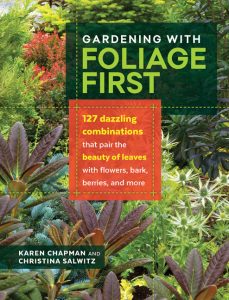 Gardening with Foliage First: 127 Dazzling Combinations That Pair the Beauty of Leaves with Flowers, Bark, Berries, and More is a recipe book for colorful and creative garden designs. The premise of the book is that flowers are lovely, but foliage is the longer-lasting ornament in a garden bed. For gardeners trying to create landscapes with year-round interest, starting with the foliage first is a wonderful approach.
Gardening with Foliage First: 127 Dazzling Combinations That Pair the Beauty of Leaves with Flowers, Bark, Berries, and More is a recipe book for colorful and creative garden designs. The premise of the book is that flowers are lovely, but foliage is the longer-lasting ornament in a garden bed. For gardeners trying to create landscapes with year-round interest, starting with the foliage first is a wonderful approach.
Authors Karen Chapman and Christina Salwitz “scoured gardens from British Columbia to Arizona and Florida to Washington State to find designs to delight, inspire, and embolden [readers] to try new ideas, new plants, and new ways of looking at plant combinations.” The resulting text is both beautiful and functional.
Read More
Posted in From the Library on January 9 2017, by Esther Jackson
Esther Jackson is the Public Services Librarian at NYBG’s LuEsther T. Mertz Library where she manages Reference and Circulation services and oversees the Plant Information Office. She spends much of her time assisting researchers, providing instruction related to library resources, and collaborating with NYBG staff on various projects related to Garden initiatives and events.
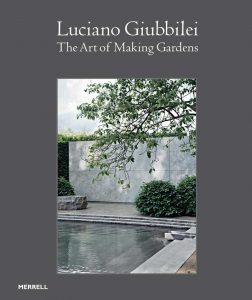 Luciano Giubbilei visited NYBG last year as one of the speakers in the 16th Annual Winter Lecture Series. Born in Siena, Italy, Giubbilei emigrated to London, England in 1994 to study at the Inchbald School of Design. In 1997 he established his own garden design practice, and over the past twenty years Giubbilei has been involved in a myriad of garden design projects and collaborations.
Luciano Giubbilei visited NYBG last year as one of the speakers in the 16th Annual Winter Lecture Series. Born in Siena, Italy, Giubbilei emigrated to London, England in 1994 to study at the Inchbald School of Design. In 1997 he established his own garden design practice, and over the past twenty years Giubbilei has been involved in a myriad of garden design projects and collaborations.
Giubbilei’s biography is a laundry list of laudable experiences, including three gold medals won at the Chelsea Flower Show in 2009, 2011, and 2014. In 2015 Andrew Wilson authored The Gardens of Luciano Giubbilei, a “testament to a life’s work in progress.” In 2016, Giubbilei followed up with his own book, The Art of Making Gardens.
Read More
 Glorious Shade from Jenny Rose Carey and Timber Press is a lovely meditation on shade gardening. Carey, the senior director at the Pennsylvania Horticultural Society’s Meadowbrook Farm, is a talented writer and photographer, and she frames her book as a conversation about shade gardening. After an introduction detailing different kinds of shade, the narrative ambles through different topics related to shade gardening, culminating in an extensive and beautifully photographed plant palette. Chapter titles include “Shades of Shade: Observing Shifting Patterns in Your Garden,” “The Gardener’s Calendar: Seasonal Changes in the Shade Garden,” “Down and Dirty: The Intertwined, Underground World of Soil and Roots,” “Planting for Success: Techniques and Maintenance,” “Designing in the Shadows: Bright Ideas of Shady Spaces,” and “The Plant Palette: Choosing Plants for Your Shade Garden.”
Glorious Shade from Jenny Rose Carey and Timber Press is a lovely meditation on shade gardening. Carey, the senior director at the Pennsylvania Horticultural Society’s Meadowbrook Farm, is a talented writer and photographer, and she frames her book as a conversation about shade gardening. After an introduction detailing different kinds of shade, the narrative ambles through different topics related to shade gardening, culminating in an extensive and beautifully photographed plant palette. Chapter titles include “Shades of Shade: Observing Shifting Patterns in Your Garden,” “The Gardener’s Calendar: Seasonal Changes in the Shade Garden,” “Down and Dirty: The Intertwined, Underground World of Soil and Roots,” “Planting for Success: Techniques and Maintenance,” “Designing in the Shadows: Bright Ideas of Shady Spaces,” and “The Plant Palette: Choosing Plants for Your Shade Garden.”








